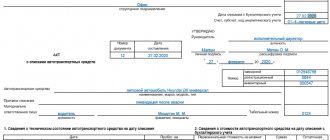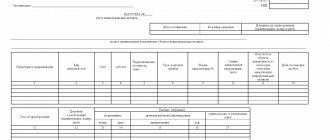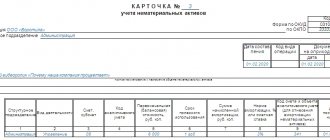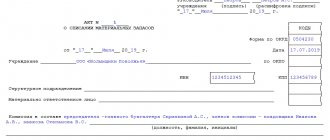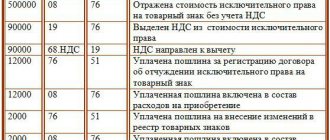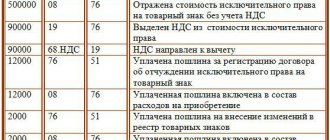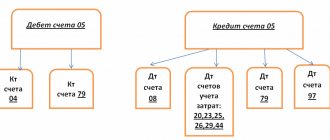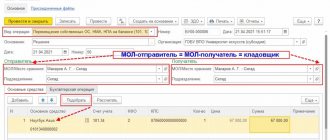How to determine the financial security code as part of the budget accounting account code?
The code in question (it is recorded in digit 18) can correspond to the following numbers:
- 1 - if the code specifies an operation at the expense of budget funds;
- 2 - if the code records a transaction at the expense of the institution’s income;
- 3 - if the transaction is carried out using funds for temporary use;
- 4 - if a subsidy for government orders is reflected;
- 5 - if a subsidy for other purposes is reflected;
- 6 - if a budget investment is reflected;
- 7 - if the operation is carried out at the expense of compulsory medical insurance funds;
- 8 or 9 - if the operation is carried out at the expense of NPO funds on personal accounts.
The element of the budget account code under consideration thus depends on the content of the transaction (financing).
Features of accounting in financial statements
Reflection of the company's NFA using accounting reporting form No. 1 - Balance sheet is carried out in certain asset lines.
In particular:
- 1110 – entering information related to intangible assets;
- 1112 – entering information taking into account the results of the study;
- 1130 – 1140 – entering information related to (non) material search tools;
- 1150 – entering information related to fixed assets;
- 1210 – entering information related to the company’s reserves.
As for the accounting principles of NFA, their choice will depend on the moment of which company needs to reflect business transactions - commercial or budgetary. When generating standard transactions, the 1st section of the chart of budget accounts is taken into account, and the chart of accounts approved by order number 94n is also used.
Information regarding non-financial (non) production assets consists of those for intangible assets, fixed assets, inventories, and depreciation by object.
The procedure for establishing such a value for various objects is reflected in the order dated December 1, 2010 under number 157n. The reliability and completeness of the reflection of information on accounting accounts is intended to be ensured by analytics in the context of objects or groups. Each type of asset must have a separate inventory card. For all movements of the NFA, supporting primary documents are used.
Tags: asset, balance sheet, accountant, capital, tax, non-financial, order, expense, means
How are synthetic NFA accounts determined in the structure of budget accounting account codes?
The list of synthetic accounts for non-financial assets in budget accounting is the information contained in the “Non-financial assets” section of Appendix 2 to Order No. 157n.
Account data in categories 19 to 23 are represented by the following main elements:
- accounting object code (digits 19, 20, 21 - for example, fixed assets with code 101);
- group code (digit 22 - for example, real estate with code 1, movable property with code 3);
- property type code (category 23 - for example, residential premises correspond to code 1, non-residential premises - 2, movable machinery and equipment - 4).
For example, transactions on fixed assets that are real estate and related to residential premises are recorded using synthetic account 10111. If fixed assets are represented by machinery and equipment, then transactions on them are reflected in the journal using synthetic account 10134.
Read more about accounting for fixed assets in the article “Budget accounting of fixed assets in 2022 - 2022 (nuances).”
Accounting for treasury property
Let's understand the concepts
So, the property treasury is movable and immovable property that is in state (municipal) ownership and is not assigned to institutions, with the exception of budget funds and consumable items. In accordance with Article 214 of the Civil Code of the Russian Federation, state property in the Russian Federation is property owned by the Russian Federation (federal property) and property owned by subjects of the Russian Federation (property of a subject of the Russian Federation). Property owned by urban and rural settlements, as well as other municipal entities, is municipal property (Article 215 of the Civil Code of the Russian Federation). The state treasury of the Russian Federation, the treasury of the constituent entities of the Russian Federation, the treasury of municipalities is, in accordance with Articles 214 and 215 of the Civil Code of the Russian Federation, state (municipal) property that is not assigned to state (municipal) institutions with the right of operational management or economic management in accordance with Articles 294, 296 Civil Code of the Russian Federation. Consequently, property (movable or immovable), being state (municipal) property, can be assigned to state (municipal) institutions with the right of operational management or economic management, and also be part of the treasury property.
General accounting rules
Accounting for federal treasury property is provided for by Decree of the Government of the Russian Federation dated July 16, 2007 No. 447, on the basis of which asset accounting and maintaining a register of federal property are carried out by: 1) Federal Agency for State Property Management in relation to property (including land plots) constituting the state treasury of the Russian Federation located abroad; 2) territorial bodies of the Federal Agency for State Property Management in relation to property (including land plots, including those provided for use by legal entities and individuals on the basis of relevant agreements), constituting the state treasury of the Russian Federation, located on the territory of the Russian Federation at its location. In accordance with paragraph 5 of the Regulations, approved by Decree of the Government of the Russian Federation No. 447, the accounting of federal property is accompanied by the assignment of a registration number to it. The procedure for maintaining the register is determined by order of the Ministry of Economic Development of the Russian Federation dated September 11, 2007 No. 307 “On approval of the Rules for maintaining the register of federal property.” Similar regulatory documents are adopted at the regional and local levels, where the procedure, method and purposes of using property in the treasury are decided (for example, Moscow Law of December 26, 2007 No. 53 “On the property treasury of Moscow”).
Features of budget accounting
The procedure for reflecting treasury property in budget accounting is not clearly presented in regulatory documents. In particular, the most general principles for accounting for treasury property are contained in Instruction No. 157n. If we compare its norms with those previously contained in Instruction No. 148n, then the new accounting rules place increased emphasis on the need to independently regulate the procedure for accounting for treasury property at the level of public legal entities. Thus, paragraph 94 of Instruction No. 157n repeatedly mentions the term “legal act on budgetary accounting of the treasury,” which should be understood as a regulatory legal act of the financial institution of a public legal entity that owns the property that makes up the treasury. Consequently, such a legal act must be adopted by each public legal entity. Also, Instruction No. 157n expands the rights of public legal entities to establish a more convenient procedure for recording treasury property in accounting, in particular, this concerns the calculation of depreciation. The legal act on budgetary accounting of the treasury may indicate the need to calculate depreciation in the manner established by the financial authority. This procedure may apply to both individual groups (types) of non-financial assets and individual objects. Fixed assets (movable and immovable property) transferred to operational management are accounted for on the balance sheet of a state (municipal) institution in accordance with paragraph 29 of Instruction No. 157n. In particular, the transfer (receipt) of objects of state (municipal) property between state authorities, local governments, institutions, as well as between accounting entities and other organizations is carried out at the balance sheet (actual) value of assets with simultaneous transfer (acceptance for accounting) in the event availability of the amount of depreciation accrued on the non-financial asset. At the same time, to account for property objects (non-financial assets) that make up the state (municipal) treasury of the Russian Federation (subjects and municipalities), in the context of tangible (intangible) fixed assets, non-produced assets and inventories, account 108 00 000 “Non-financial assets of property” is provided treasury." At the same time, property items included in the treasury are reflected in budget accounting in value terms without maintaining inventory and analytical accounting (clause 143 of Instruction No. 157n). >|The procedure for maintaining analytical accounting for objects included in the treasury property based on information from the property register of the relevant public legal entity is established by the financial authority of the relevant budget.|
Rules for reflecting the situation on accounts
The frequency of reflection in budget accounting of transactions with objects that make up the state (municipal) treasury based on information from the property register of the relevant public legal entity is established by the financial authority of this budget institution, but not less often than on the reporting monthly date.
However, the financial body of the appropriate budget has the right to establish a different procedure for inventory and analytical accounting of treasury property objects of the corresponding public legal entity. At the same time, when establishing the procedure for inventory and analytical accounting of treasury property objects, it should be taken into account that these assets are not transferred to fixed assets in account 101 00 000 “Fixed Assets”, but are reflected in non-financial assets of treasury property in account 108 00 000. In accordance with paragraph 29 of Instruction No. 157n, the transfer of state (municipal) property objects is carried out at the balance sheet (actual) value of the accounting objects with simultaneous transfer (acceptance for accounting) in the event of the amount of depreciation accrued on the non-financial asset. Example 1.
An institution (federal hospital) donated medical equipment as part of the property of the municipal treasury. The book value of the equipment is 38,000 rubles, the amount of previously accrued depreciation is 8,000 rubles. The following entries were made in the accounting records:
| Contents of operation | Debit | Credit | Amount, rub. |
| Fixed assets (equipment - other movable property of the institution) were transferred free of charge to the treasury property | 1 401 20 251 “Expenses on transfers to other budgets of the budget system of the Russian Federation” | 1 101 34 410 “Reduction in the cost of machinery and equipment - other movable property of the institution” | 38 000 |
| Previously accrued depreciation was transferred upon gratuitous transfer of fixed assets (equipment) | 1 104 34 410 “Reduction due to depreciation of the cost of machinery and equipment - other movable property of the institution” | 1 401 20 251 “Expenses on transfers to other budgets of the budget system of the Russian Federation” | 8000 |
Ultimately, the residual value of the property transferred to the treasury property will be attributed to the financial result of previous reporting periods (when closing budget accounting accounts), as determined by Order of the Ministry of Finance of Russia dated December 6, 2010 No. 162n “On approval of the chart of accounts for budget accounting...” . The basis for writing off the transferred assets from the register are primary documents (Act on acceptance and transfer of fixed assets (except buildings, structures) (f. 0306001), Act on acceptance and transfer of the building (structure) (f. 0306030) with the attachment of documents on the state registration of termination of the right to operational management of real estate or their certified copies in cases established by the legislation of the Russian Federation, and Notice (f. 0504805)). Accounting records are prepared for both the write-off of the original cost and the amount of depreciation accumulated for this object. If the transfer of an object to the treasury property is carried out by a budgetary institution of a new type, then it is necessary to be guided primarily by paragraph 12 of the Instruction, approved by order of the Ministry of Finance of Russia dated December 16, 2010 No. 174n. Example 2.
A new type of budgetary institution donated medical equipment to the founder - especially valuable movable property as part of the treasury property, previously acquired through a subsidy for the implementation of a state (municipal) task. The book value of the equipment is 380,000 rubles, the amount of previously accrued depreciation is 80,000 rubles. The following entries were made in the accounting records:
| Contents of operation | Debit | Credit | Amount, rub. |
| Fixed assets were transferred free of charge (equipment - especially valuable movable property of the institution) | 4 210 06 560 “Increasing settlements with the founder” | 4 101 24 410 “Reducing the cost of machinery and equipment - especially valuable movable property of the institution” | 380 000 |
| Previously accrued depreciation was transferred upon gratuitous transfer of fixed assets (equipment) | 4 104 34 410 “Reduction through depreciation of the cost of machinery and equipment - especially valuable movable property of the institution” | 4 210 06 660 “Reducing settlements with the founder” | 80 000 |
But what if the transferred property was already included in the treasury of the institution? In this case, the gratuitous transfer of assets is carried out within the framework of intradepartmental, interdepartmental and interbudgetary transfer, as well as within the framework of transfer to state and municipal enterprises. In this case, treasury property objects are transferred at their original cost with the simultaneous transfer of amounts of previously accrued depreciation. Free transfer of treasury property to other organizations (except for state and municipal ones) and individuals is carried out at residual value. In this case, the amount of previously accrued depreciation must be written off from the debit of account 1,104,00,000 to the credit of account 1,108,00,000 “Non-financial assets of treasury property.” We will analyze the accounting records in the cases under consideration using an example. Example 3.
A municipal institution transferred a non-residential building from the municipal treasury to operational management. The initial cost of the building is 720,000 rubles, the amount of accrued depreciation is 480,000 rubles. The transferring party is not the founder of this budgetary institution. The transfer of a non-residential building in the accounting of the transferring party is reflected by the following entries:
| Contents of operation | Debit | Credit | Amount, rub. |
| A non-residential building was transferred to the operational management of a budgetary institution | 401 20 241 “Expenses for gratuitous transfers to state and municipal organizations” | 108 51 410 “Reduction in the value of real estate that makes up the treasury” | 720 000 |
| The amount of previously accrued depreciation is written off | 104 51 410 “Reduction due to depreciation in the value of real estate as part of treasury property” | 401 20 241 “Expenses for gratuitous transfers to state and municipal organizations” | 480 000 |
If treasury property has fallen into disrepair and is not subject to further use, it can be written off from the balance sheet.
The procedure for recording the write-off of treasury property that has become unusable as a result of dilapidation (wear and tear), damage, shortage, theft, terrorist act, natural and other disasters is not given in the Accounting Instructions. At the same time, the main managers of budget funds, financial authorities and treasury authorities have the right to determine the correspondence of accounts necessary for reflection in budget accounting in the event of its absence (state the accounting option in the accounting policy). In my opinion, when writing off treasury property that has fallen into disrepair, the following entries can be used. 1. When writing off treasury property that has become unusable, debit account 401 10 172 “Income from transactions with assets” and credit accounts at residual value (at the same time, the amounts of accrued depreciation are written off). 2. Write-off of treasury property that has fallen into disrepair as a result of natural and other disasters, dangerous natural phenomena, catastrophes is reflected in the debit of account 401 20 273 “Extraordinary expenses on operations with assets” at the residual value (depreciation amounts are written off at the same time). 3. The write-off of missing and stolen treasury property is reflected using account 401 10 172 “Income from transactions with assets.” In this case, the amount of accrued depreciation is also subject to write-off. The article was published in the journal “Accounting in Budgetary Institutions” No. 1, January 2012.
Hello Guest! Offer from "Clerk"
Online professional retraining “Accountant on the simplified tax system” with a diploma for 250 academic hours . Learn everything new to avoid mistakes. Online training for 2 months, the stream starts on March 15.
Sign up
How to determine the transaction code for a budget accounting object?
Another element of the budget accounting account code is the transaction code with the object of the corresponding accounting in government administration, or KOSGU. It's three digits.
When transacting with an NFA, its 2nd and 3rd digits (that is, the 25th and 26th digits of an account under a single plan) can correspond to the following numbers:
- 10 - if an item of fixed assets is taken into account;
- 20 - if intangible assets are taken into account;
- 30 - if non-produced assets are taken into account;
- 40 - if inventories are taken into account.
Digit 24 of the account according to a single plan for transactions with non-financial assets can correspond to numbers 3 or 4, if, accordingly, the arrival or disposal of assets is recorded.
Non-productive intangible assets
What it is? Non-productive intangible non-financial assets are legal forms that are formed in the production process and are capable of moving from one unit (institutional) to another. These include documents allowing the owner to engage in specific activities. At the same time, they exclude other units (institutional) from this functioning, except with the permission of the owner.
These assets include:
1. Leases and various transferable agreements (acquired goodwill - notional estimated value of goodwill).
2. Objects of patenting are the latest inventions, which are characterized by technical novelty, which are provided with judicial protection on the basis of the law.
Results
Accounting for non-financial assets in budgetary institutions is carried out by entering information about business transactions with the corresponding assets in a special journal. The key element of this information is the budget accounting account codes. When accounting for non-financial assets in government institutions, they are unique for each type of NFA and are determined based on the standards established by orders of the Ministry of Finance of Russia dated December 1, 2010 No. 157n and dated December 6, 2010 No. 162n.
Sources: Order of the Ministry of Finance of Russia dated December 1, 2010 No. 157n
You can find more complete information on the topic in ConsultantPlus. Free trial access to the system for 2 days.
The concept of non-financial assets, their classification
Non-financial assets are usually understood as objects that are owned or used by organizations and bring them a certain amount of economic benefit.
Types of non-financial assets: non-produced and produced.
Non-financial produced assets appear as a result of production processes and include three main elements: fixed assets (operating in industries that produce goods and provide services); material reserves; values.
Non-produced non-financial assets are assets that are not the result of production processes (land, intellectual property).
In accordance with clause 22 of Appendix No. 2 to Order No. 157n of the Ministry of Finance of the Russian Federation dated December 1, 2010, the following main categories of NFA are used in the accounting of budgetary organizations of the Russian Federation:
- fixed assets of the subject (movable, immovable property used in economic activities);
- assets related to intangible (intellectual property), non-produced (land plots, subsoil);
- material reserves of the subject (fuels and lubricants, equipment, food, building materials);
- property belonging to the state treasury (precious metals, intangible assets of the appropriate type, non-productive assets).
- Costs of production of finished products, performance of work, provision of services, including:
- The cost of finished products, works, services - direct costs or expenses.
- Overhead costs are indirect costs that accompany the main production, but are not directly related to it. For example: expenses for maintaining property, travel expenses, expenses for training employees.
- General running costs
An organization’s NFA can carry out the following operations:
- receiving or creating;
- disposal.
These transactions are recorded in a separate transaction log based on primary documents.
In addition, the accounts in the “Non-financial assets” section of the Unified Chart of Accounts are intended to collect, register and summarize information on transactions related to: disposal (transfer, sale, write-off from the balance sheet) of non-financial assets; receipt (purchase) of non-financial assets; creation (production, construction, construction) of non-financial assets; formation of the amounts of actual investments of the institution (organization exercising the powers of the recipient of budget funds) in objects of non-financial assets; formation of the value of the accounting object; costs of manufacturing finished products, performing work (rendering services); non-financial assets in transit.
